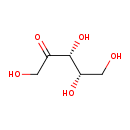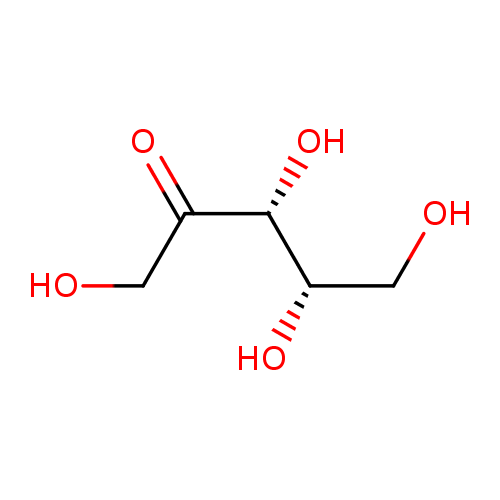|
Record Information |
|---|
| Version |
1.0 |
|---|
| Update Date |
1/22/2018 11:54:54 AM |
|---|
|
Metabolite ID | PAMDB110576 |
|---|
|
Identification |
|---|
| Name: |
D-xylulose |
|---|
| Description: | The D-enantiomer of xylulose. |
|---|
|
Structure |
|
|---|
| Synonyms: | -
xylulose
-
D-threo-pentulose
|
|---|
|
Chemical Formula: |
C5H10O5
|
|---|
| Average Molecular Weight: |
150.13 |
|---|
| Monoisotopic Molecular
Weight: |
150.0528234315 |
|---|
| InChI Key: |
ZAQJHHRNXZUBTE-WUJLRWPWSA-N |
|---|
| InChI: |
InChI=1S/C5H10O5/c6-1-3(8)5(10)4(9)2-7/h3,5-8,10H,1-2H2/t3-,5+/m1/s1 |
|---|
| CAS
number: |
551-84-8 |
|---|
| IUPAC Name: | D-threo-pent-2-ulose |
|---|
|
Traditional IUPAC Name: |
xylulose |
|---|
| SMILES: | C(O)C(O)C(O)C(=O)CO |
|---|
|
Chemical Taxonomy |
|---|
|
Taxonomy Description | This compound belongs to the class of chemical entities known as pentoses. These are monosaccharides in which the carbohydrate moiety contains five carbon atoms. |
|---|
|
Kingdom |
Chemical entities |
|---|
| Super Class | Organic compounds |
|---|
|
Class |
Organic oxygen compounds |
|---|
| Sub Class | Organooxygen compounds |
|---|
|
Direct Parent |
Pentoses |
|---|
| Alternative Parents |
|
|---|
| Substituents |
- Pentose monosaccharide
- Beta-hydroxy ketone
- Acyloin
- Alpha-hydroxy ketone
- Secondary alcohol
- Ketone
- Polyol
- Organic oxide
- Hydrocarbon derivative
- Primary alcohol
- Carbonyl group
- Alcohol
- Aliphatic acyclic compound
|
|---|
| Molecular Framework |
Aliphatic acyclic compounds |
|---|
| External Descriptors |
|
|---|
|
Physical Properties |
|---|
| State: |
Liquid |
|---|
| Charge: | 0 |
|---|
|
Melting point: |
15 °C |
|---|
| Experimental Properties: |
| Property | Value | Reference |
|---|
| Melting Point | 15 °C | Not Available | | Boiling Point | Not Available | Not Available | | Water Solubility | Not Available | Not Available | | LogP | Not Available | Not Available |
|
|---|
| Predicted Properties |
|
|---|
|
Biological Properties |
|---|
| Cellular Locations: |
Not Available |
|---|
| Reactions: | |
|---|
|
Pathways: |
Not Available |
|---|
|
Spectra |
|---|
| Spectra: |
|
|---|
|
References |
|---|
| References: |
- Huck JH, Roos B, Jakobs C, van der Knaap MS, Verhoeven NM (2004)Evaluation of pentitol metabolism in mammalian tissues provides new insight into disorders of human sugar metabolism. Molecular genetics and metabolism 82, Pubmed: 15234337
|
|---|
| Synthesis Reference: |
Takeuchi, Sonoko; Tonouchi, Naoto; Yokozeki, Kenzo. Production of xylitol or D-xylulose by fermentation of glucose with Gluconobacter, Acetobacter, and Frateuria. Eur. Pat. Appl. (2000), 10 pp. |
|---|
| Material Safety Data Sheet (MSDS) |
Download (PDF) |
|---|
|
Links |
|---|
| External Links: |
|
|---|


